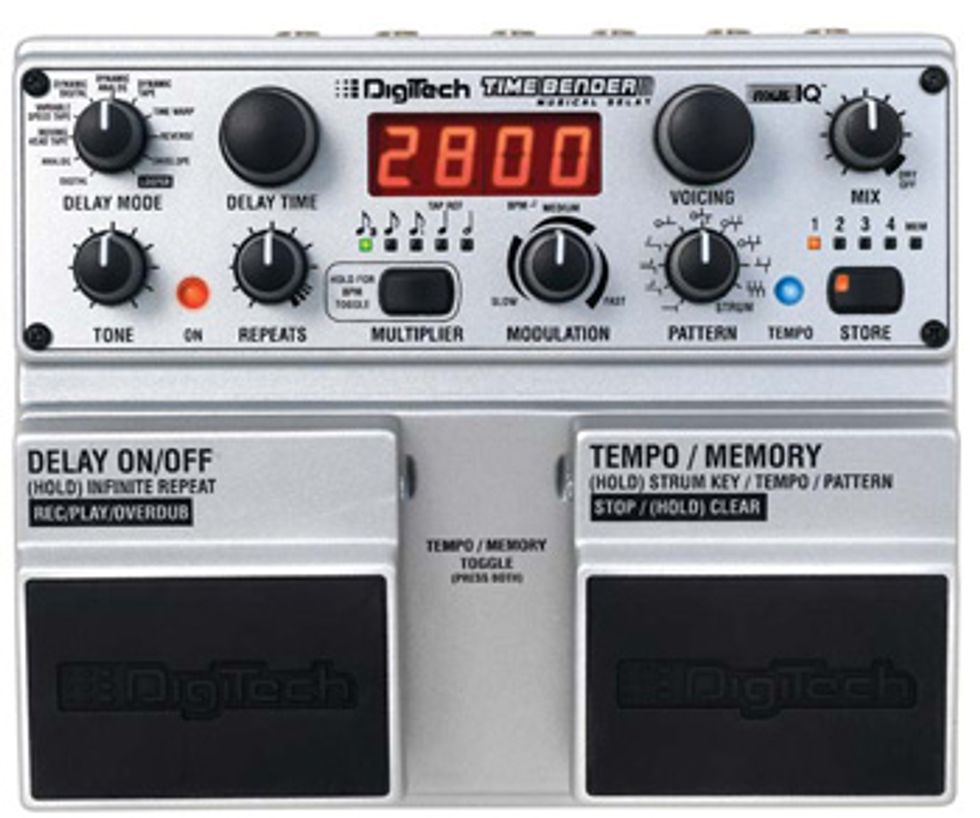Delay effects can enhance your sound in almost any musical genre. There are dozens of analog, digital, and even a few tape models available, but three additions have come up with some new twists, making them worth a look.
Digitech TimeBender 
I could set the delay time by tapping the right footswitch, or set it by holding that switch down, damping the guitar’s strings, and strumming the tune’s tempo. I found
| Download Example 1 Dotted Strum | |
| Download Example 2 Pettern Voice | |
| Recorded with a 1965 Stratocaster into an Orange Tiny Terror head powering a mic'd 1x12. | |
The Voice knob delivers three octaves of pitch-shifted delays. Unlike on some delays, these do not continue up or down in pitch with each repeat, but stay right where they are, creating inspiring effects like those in clip 2. Holding the right pedal down while strumming a chord automatically places these intervals in the chord’s key.
The Envelope setting let me create stuttering slicer effects. I could set the rhythm of the repeats for this, or any delay effect, to ten different patterns. I could also create my own patterns by setting the Pattern selector to Strum, holding down the right pedal, and strumming the rhythm of my choice. As with the DL4, an optional expression pedal will let you set two completely different parameter settings—heel and toe—for each memory slot (within the same delay type).
The TimeBender’s looper does not offer the DL4’s half-speed and reverse loop options, or its ready accessibility of three memory switches (the TimeBender requires stepping through its four memory slots or buying an optional footswitch). It does, however, let you use pitch-shifting effect during looping, to create bass lines or high chiming parts.
With all the aforementioned features (and a few more tricks up its sleeve), the TimeBender enters the field as a serious contender for the top of any delay lover’s list.
Buy if...
delay is a major part of your musical expression.
Skip if...
all you need is a rockabilly slapback.
Rating...
Street $159 - DigiTech - digitech.com |
Guyatone Mighty Micro MDm5 Micro Delay
 | |
| Download Example 1 Country Slapback | |
| Download Example 2 Feedback | |
| Recorded with a 1965 Stratocaster into an Orange Tiny Terror head powering a mic'd 1x12. | |
The MDm5 Micro Delay offers from 30 to 2600 milliseconds of delay in a 3-3/4” x 1/2” x 2-1/2” enclosure. Present are the usual controls— blend, delay time, and feedback—to which the MDm5 adds a sliding switch that lets you choose among three time ranges—short, medium, and long. A tiny knob rolls off the highs for more lo-fi, analog sound, keeping the delays from obscuring your original signal.
The Mighty Micro let me cover most of the common delay bases, from country slap [clip 1] to ambient washes. It also demonstrated runaway feedback oscillation capability and the ability to smoothly shift the pitch of the delay as I turned the delay knob. This combination created the cool Tommy Bolin/Billy Idol sound effects in clip 2.
Don’t let its size fool you: the MDm5 will sit sonically with many boutique pedals, while leaving room to cram a few more on your board.
Buy if...
you want a versatile delay but are short on pedalboard space.
Skip if...
you need tap tempo and modulation.
Rating...
Street $190 - Guyatone - guyatone.com |
Electro-Harmonix #1 Echo
 | |
| Download Example 1 Reverb | |
| Download Example 2 Loop | |
| Recorded with a 1965 Stratocaster into an Orange Tiny Terror head powering a mic'd 1x12. | |
The joys of any Electro-Harmonix pedal lie in its unique quirks. In the case of the #1 Echo, this means that the shortest delay times create a kind of comb filter sound. This is an extreme effect, but you can bet some inventive picker will find a use for it.
Buy if...
you need maximum digital clarity for minimum cash.
Skip if...
you need more features.
Rating...
Street $99 - Electro-Harmonix - ehx.com |















![Rig Rundown: AFI [2025]](https://www.premierguitar.com/media-library/youtube.jpg?id=62064741&width=1245&height=700&quality=70&coordinates=0%2C0%2C0%2C0)












 Shop Scott's Rig
Shop Scott's Rig